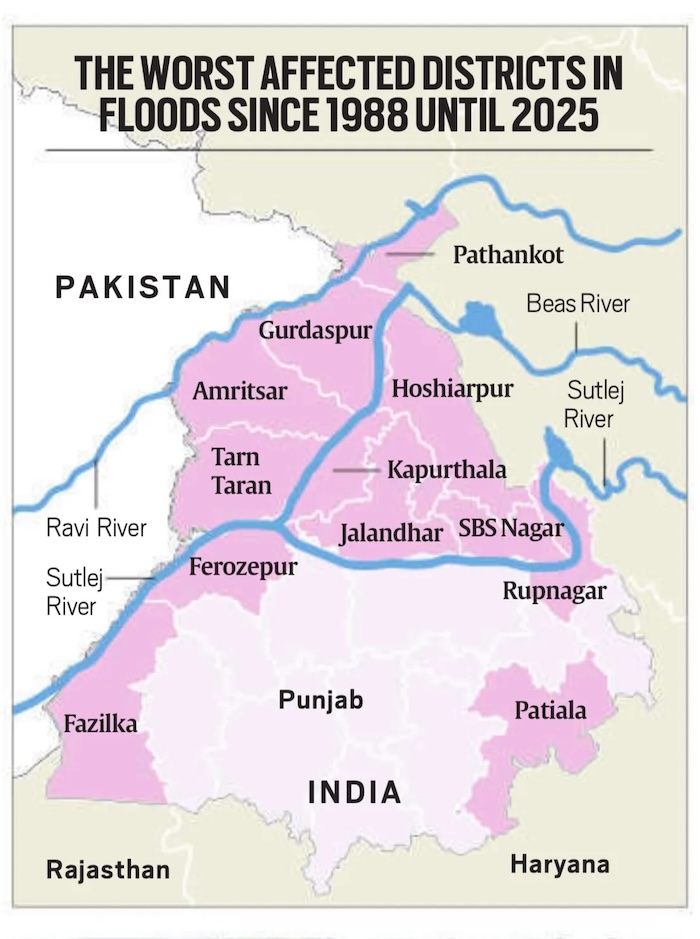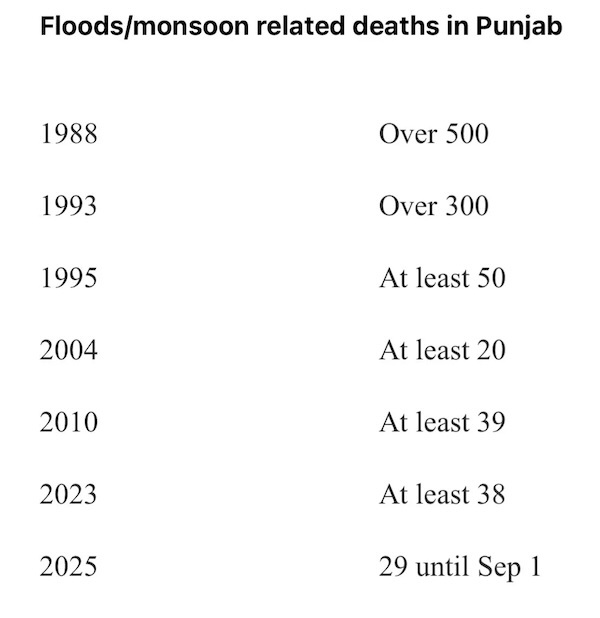Floods in Punjab
This is a collection of articles archived for the excellence of their content. |
History
1988, 1993, 2023
Divya Goyal, Sep 3, 2025: The Indian Express

From: Divya Goyal, Sep 3, 2025: The Indian Express

From: Divya Goyal, Sep 3, 2025: The Indian Express
According to a report published by the Indian Meteorological Department (IMD), Pune, the 1988 floods in Punjab, Haryana and Himachal Pradesh, and in states such as Assam, Arunachal Pradesh, Bihar, etc., were among the “four most disastrous weather events” that year, with three others being cyclonic storm in West Bengal, severe heatwave over Madhya Pradesh and Rajasthan and heavy snowfall over Jammu & Kashmir.
The 1988 floods claimed more than 1,400 lives in the north, including at least 685 in Punjab, Haryana and Himachal. In Punjab alone, 535 people died as per reports. But according to the Punjab government, 383 died and 62 were missing.
According to the IMD report, while the incessant rains in Punjab that year had started in March, the worst came in September when the three overflowing rivers, Sutlej, Ravi and Beas, wreaked havoc. From Gurdaspur to Ludhiana, Jalandhar to Sangrur, almost the entire Punjab was flooded.
On March 11, 1988, flash floods in the Ravi hit Gurdaspur district, killing one person and inundating 40 villages, which remained cut off for three days. From July 3 to 7, heavy rains in Patiala claimed three lives and submerged one-third of the city, 12 buildings collapsed, and over 20,000 people were rendered homeless. In Hoshiarpur, Jalandhar and Ropar, canal links were washed away at several places.
The worst, however, started in the second week of July when the overflowing Sutlej and Ravi inundated Amritsar, Bathinda, Gurdaspur, Ferozepur, Hoshiarpur, Jalandhar, Ludhiana, Patiala, Kapurthala and Sangrur. At least 38 people died, 208 cattle perished, crops were destroyed in 200 villages, and 8,900 houses were destroyed.
From September 4 to October 2, the three rivers overflowed like never before, claiming 57 more lives across Punjab, leaving 2 lakh people marooned in 1,483 villages and destroying crops worth crores of rupees in Amritsar, Bathinda, Ferozepur, Gurdaspur, Hoshiarpur, Jalandhar, Kapurthala, Ludhiana, Patiala and Ropar. At least 74,000 tonnes of foodgrain were also destroyed in mandis, according to the IMD document.
However, the worst happened in September last week when the floodgates of Bhakra and Pong dams were opened after unprecedented rainfall in catchment areas in just three days from September 23 to 26.
Claiming that the floodgates of both dams were opened to release lakhs of cusecs of water as a “conspiracy to finish Punjab”, militants had assassinated then BBMB chairman Major General BN Kumar in November 1988.
1993 floods
Five years later, in 1993, Punjab again faced devastating floods, claiming over 300 lives and 6,200 cattle perishing. The worst affected were Amritsar, Gurdaspur, Ludhiana, Patiala, Fatehgarh Sahib, Hoshiarpur, Ferozepur, and Sangrur, among others.
Breaches caused 1993 floods: PRSC study
A comparative study of 1988 and 1993 floods conducted by the Punjab Remote Sensing Centre (PRSC) in Ludhiana, using images from space technology, suggested that “in 1988, the flooding was mainly due to overflowing of rivers, whereas in 1993, it was caused by breaches in rivers and canals’ embankments”.
According to the study, almost 18 per cent of Punjab was flooded in 1988, while in 1993, at least 19.4 per cent area was flooded.
The PRSC study highlighted “some human causes leading to flooding” in Punjab, including: poor maintenance of dhussi bandhs and embankments on the rivers resulted in several breaches and weak and vulnerable patches, lack of maintenance of canals and choe banks resulted in breaches, and an inadequate drainage system designed to pass only a portion of high flood discharge, among others.
The study concluded: “Flood disasters could be greatly reduced if managed properly and preventive measures are adopted beforehand.” It added: “The natural drainage of the state has been partially disrupted with the laying of canals, construction of railway tracks, roads and cultivation on natural watercourses which need to be restored.”
PAU study: climate change a major cause for 2023 floods The 2023 floods in Punjab were induced by climate change, which led to incessant and uneven rainfall, said the study “Punjab Floods 2023: Causes, Impacts and Learnings” by Punjab Agricultural University (PAU) in Ludhiana.
“Climate change-induced climatic extremes are becoming frequent with the passage of time. The incessant rainfall in Himachal from July 7-11, 2023, was 436% above the normal, and caused heavy flooding in the downstream tracts of Punjab. The overflowing water entered Punjab through the Beas, Ghaggar and Sutlej. Nearly 2.21 lakh hectares of cropped area, mainly under paddy, got damaged,” it said.
Floodplains encroached, weak bandhs, unclean drains: Lapses all the way
A study “Punjab Floods: Some Lessons Learnt for Future Management” by Sucha Singh, assistant professor, geography, Panjab University, Chandigarh, conducted following the 2013 flooding, saysa: “Despite master plans on disaster management, especially relating to flood management in almost all districts of Punjab, the state failed to minimise the flood induced damage to thousands of acres of cropped area as well as the loss of settlement area.”
According to the study, the major reasons included breaching of temporary embankments along rivers and increasing encroachments on the floodplains of the rivers.
“The construction, strengthening and maintenance of embankments on Sutlej, Beas and Ravi rivers and on canal drains were not carried out properly due to some financial constraints and less political support from the concerned ministers and officials…” said the study.
Another study titled “Temporal analysis of floods in Punjab, India 1990 to 2010,” said that “floods are a major natural phenomenon” and Punjab witnessed “heavy rain in the catchment area of the rivers”, but flooding also happened due to “mismanagement”.
Major causes of flood in the state as per the study were: the tributaries were not cleaned, water overflowed and breached embankments, non-strengthening of the river bandhs, farmer made relief cuts in canal at many locations etc.
Dr Gurdev Singh Hira, retired additional director research, PAU, with specialisation in water and soil sciences, said: “Floods are not man-made, but the damage is being aggravated due to man’s actions and inactions. The concretisation and deforestation in Himachal Pradesh are a major reason for such water disasters. Climate change is changing rain patterns in the subcontinent, and Punjab on both sides of the border is the most vulnerable, being the land of five rivers.”
2025: echoes of 1988
Neel Kamal, Sep 1, 2025: The Times of India
Bathinda : Heavy rain in catchment areas of J&K and Himachal, subsequent release of water from dams, and a 74% rainfall surplus in the state in Aug left Punjab grappling with its most severe floods since 1988. From the morning of Aug 25 to 26, Punjab saw 1,643% excess rainfall, while the state recorded a 1,272% excess from Aug 24 to 25. It recorded a 957% excess with 24.3mm of rain against a normal of 2.3mm in 24 hours from the morning of Aug 30 to 31.
The swollen rivers of Ravi, Beas, and Sutlej submerged seven districts of Punjab, and additional rain led to inundation in other towns and districts across state. In past 24 hours, Nakodar in Jalandhar recorded 90mm of rain, while Garhshankar in Hoshiarpur district logged 70mm.
2 killed in state: Rain-related incidents claimed two lives Sunday. Jagjiwan Singh, 60, was cycling in Jawaharke village near Mansa when the boundary wall of a factory collapsed upon him, killing him on the spot. In Sangatpura village of Sangrur, Karamjit Kaur, 60, was killed and her daughter Mandeep injured when the roof of their house collapsed due to heavy rain.